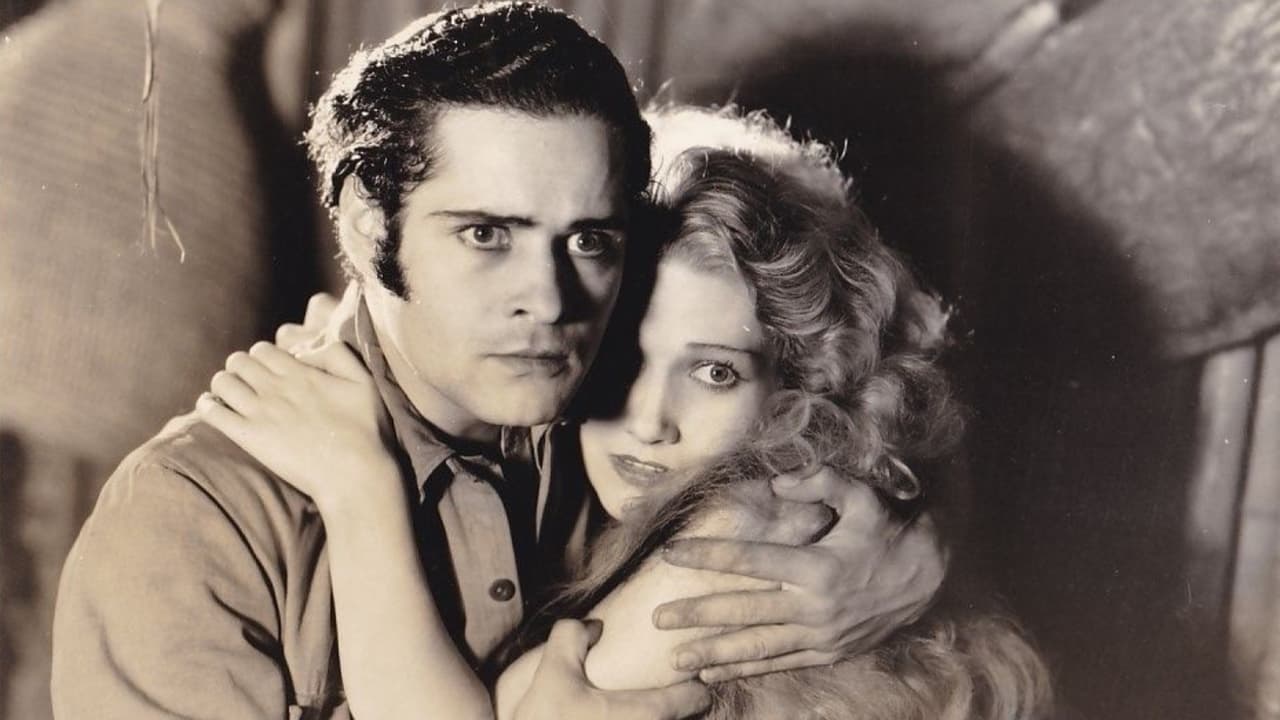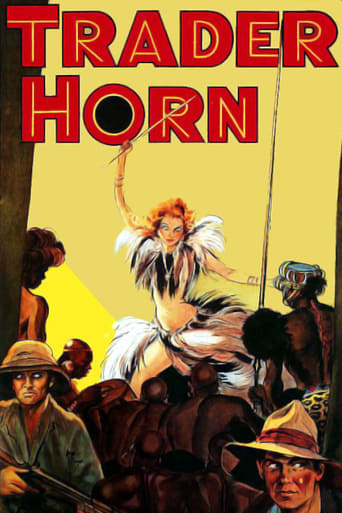

Allegedly photographed in Tanganyika, Kenya, Uganda, the Anglo- Egyptian Sudan and the Belgian Congo. Some of the picture actually was. Most of it, however, was either secretly photographed in Mexico or in good old M-G-M's Culver City studios. Producer: Irving Thalberg.Copyright 26 March 1931 by Metro-Goldwyn-Mayer Distributing Corp. New York opening at the Astor: 3 February 1931. U.S. release: 22 January 1931. 13 reels. 11,109 minutes. 123 minutes.SYNOPSIS: A trader and his partner rescue a missionary's daughter from African cannibals.NOTES: Nominated for an Academy Award for Best Picture, losing to Cimarron.Number seven at U.S./Canadian ticket windows, "Trader Horn" also figured in the year's top ten most popular films in Australia. Oddly, the movie was never re-issued in Oz, nor has it ever been aired on Oz TV.A sequence in which Cecil B. DeMille introduces the real Alfred Aloysius Horn to the audience has been removed from the video print under review.Only film of Mutia Omoolu. Also film debut of Edwina Booth, who teamed up with Harry Carey again for the 1931 Mascot serial "The Vanishing Legion". Suffering from jungle fever acquired whilst filming "Trader Horn", she then retired from the screen, after successfully suing M- G-M for a large sum of money. She was still alive in the late 1980s.COMMENT: Wow! Probably the most exciting African adventure ever made, "Trader Horn" retains every one of its thousand thrills in these more sophisticated nineties. A pungent script, allied with Van Dyke's driving, resourceful direction overcomes some primitive sound recording, occasionally choppy film editing and players that vary from the absolutely wonderful (beguiling Edwina Booth) and surprisingly personable (Mutia Omoolu), through the thoroughly if somewhat off-handedly professional (Harry Carey) to the downright awful (Duncan Renaldo, who seems as out of place in the Kenyan veldt as a slug on a geranium)."Trader Horn" was so successful, it spawned M-G-M's Tarzan series (which uses the same exotically atmospheric theme music, plus De Vinna's out-takes and stock footage).OTHER VIEWS: Van Dyke piles thrills upon thrills in this savage, stingingly authentic jungle marathon in which not a split second is wasted on anything but socko entertainment. - Photoplayer.
... View Moreyoung Renaldo some of the integration of clips is poor--wrong size/perspective bare breasts, animal violence--pre-code staged actual animal fights in Mexico! animal cruelty you black ape... monkeys Naked Prey"Trader Horn" is a very good film, but it's also a monstrous film--a very strange combination. I noticed that I my wife and I watched it, she was terrified and even angered several times--mostly because the filmmakers were so darned irresponsible in the way they treated the animals (and even cast members!).The film begins with Horn (Harry Carey) and Peru (Duncan Renaldo) trekking through Africa with their porters and Horn's assistant, Rencharo (Mutia Omoolu). They are looking to trade salt and trinkets to the locals for ivory and furs. But, instead of taking advantage of the naiveté of these tribesmen, the tables end up getting turned on them. Despite Horn's experience on the Continent, he's finally out of his league--among incredibly hostile natives who seem bent on killing them all. In an odd twist, they meet up with a savage white woman living among these locals and they take 'Nina' with them on a cross-country run from these hostile warriors. This portion of the film is highly reminiscent of the later film "The Naked Prey" (with Cornel Wilde).While the film is exciting and has a lot of great action location sequences, the film also is very tough to watch. Because the film was made in the Pre-Code era (where rules about film content were rarely enforced), the film is amazingly violent. In fact, MGM didn't like the final product, so they took a bunch of animals (probably from circuses or zoos) to Mexico and had them kill each other or killed them outright and stuck this into the movie!! There was no PETA or American Humane Association to oversee the project and it is tough watching animals actually die. In particular, there is a scene where a lion is impaled on a spear and it appears that they really did this for the entertainment of the audiences! Uggh. Additionally, being a Pre-Code piece, Nina spends much of the movie wearing very little--and all the native women are topless--which was not a problem in 1931. However, with the toughened Production Code of 1934, this film would have been heavily edited to be shown in the States or not at all. Because of all this, it's a film you definitely cannot ignore!! Exciting location shots, lots of action and a bit of trash--all make for a very exciting but unsavory film.
... View MoreTRADER HORN is somewhat of an endurance test to watch. The first hour is a compilation of animal wildlife footage filmed entirely on "The Dark Continent", which looks even darker in the murky B&W cinematography on display here.The plot doesn't pick up until the first hour is over, thanks to the entry of EDWINA BOOTH, a white woman who seems like a threat to both Trader Horn (HARRY CAREY) and his young hunter friend (DUNCAN RENALDO), a naive young fellow who is constantly being tutored and lectured by the grizzly older man who knows all about the jungle. But once the threat is over, she becomes a safari mate and the two men fight over protecting her as they make their way through some dangerous turf.Most of the wildlife footage is seen at a distance and is the sort of footage that would later adorn the Johnny Weissmuller films at MGM whenever a Tarzan film needed some extra background shots. It's definitely not up to the standards that "Wild Kingdom" achieved in color film much later on.Booth, a very beautiful woman, makes an interesting impression once she settles down to give a performance, and the men do the best they can with the material on hand. Carey seems not an ideal choice for the leading role and his character never has much warmth, but Duncan Renaldo does nicely as his sidekick, boyishly enthusiastic about every sort of adventure awaiting them.It's an uneven film, hurt by its excessive length and the fact that there is very little plot development until the film is past the midway point--and even then, it ambles slowly toward a sluggish conclusion.The crew deserves praise for putting up with six months of the shooting schedule in darkest Africa, but it's doubtful that today's viewers will be satisfied with the slow moving tale burdened by dark, murky looking photography.As is often the case with movies from this era, there is no background music at all on the soundtrack except for the opening title credits.
... View MoreW(oodbridge) S(trong) Van Dyke (1889-1943) directed the MGM motion picture TRADER HORN in 1930 and later wrote a book about the production titled HORNING INTO Africa (1931). This was the first major Hollywood picture to shoot on location in Africa, which in this case meant Kenya and the Belgian Congo. Van Dyke hired professional big game hunters Sydney Waller and Dicker Dickenson to provide both the action footage and the meat required for the film crew's daily rations.HORN starred Harry Carey, Edwina Booth, Aubrey Smith, and Duncan Renaldo. Miss Booth, who bravely agreed to wear the horrendous makeup required for her character (ultra-realistic when you compare it to later "lost white princesses" like Sheena and the woman in JUNGLE GODDESS) nearly died from a severe case of malarial fever caught while in the Congo. Van Dyke produced so much stock footage of African crocodiles, wildlife, and scenery that it was recycled for years in Hollywood films about the Dark Continent, including the great MGM TARZAN movies starring Johnny Weissmuller and the incomparable Maureen O'Sullivan.TRADER HORN has been re-mastered and is an amazing document of Old Africa, providing footage of local cultural life and a long-lost wildlife paradise. Much of the natural history information given in the film (the lead character gives his protégé sort of a guided tour of the Serengeti) is more accurate than that contained in most hunting books of the time. There are also some authentic hunting sequences, as well as numerous "staged" battles like that between a pair of leopards and some hyenas.Incidentally, the crew of TRADER HORN was widely blamed for disrupting the local economy, at least by the colonials and at least as far as visiting photographers and film-makers were concerned. The story goes that the production unit wanted footage of a particularly impressive East African tribal chief, and offered him the sum of £40 pounds for the privilege. That amount was many, many times the going rate, and the local people immediately realized that they had been getting ripped off for years. MGM set the new price; even twenty years later Masai and Samburu warriors were often demanding as much as £1 for a still photo, and the colonials were still complaining about it.A remake of TRADER HORN was made in 1973. Starring Rod Taylor and Anne Heywood, it was so bad that the studio almost canceled its release. It is particularly remarkable for Taylor's performance as an Englishman; judging from his accent he was born in a quaint English cottage on the South Side of Chicago.
... View More